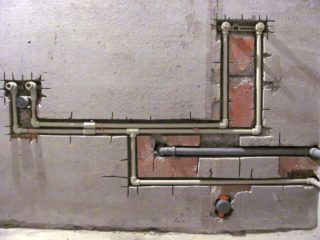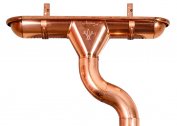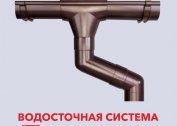When carrying out repair work in the bathroom, you should take care of the aesthetics of the room. A large amount of communication needs to be hidden from the eyes of households and guests. To hide the sewer pipe in the bathroom, you need to know the basic methods of masking. Each of them is distinguished by its features, advantages and disadvantages.
Why hide sewer pipes in the bathroom
The issue of decorating and masking communications in the bathroom is an opportunity to solve several problems at the same time:
- Improving the appearance of the room. Pipes hidden from prying eyes do not overload the room. The bathtub looks aesthetically pleasing.
- Visual expansion of space. Communications do not “cut” the floor, ceiling and walls visually.
- Additional soundproofing. Plastic, due to its relative stiffness, conducts sounds well. The media transported through the sewage system create characteristic noises in the room.
Before carrying out repair work, a number of basic rules must be taken into account to avoid gross errors and violations.
Pipe masking rules
In order not to later encounter the need for complex emergency operations, it is necessary to close the sewer pipes in accordance with the following recommendations:
- When installing the sewer line, complex connections, right and acute angles should be avoided.
- You can hide behind the cladding and other decorations only those pipes that are joined by soldering. It is forbidden to close the pipeline with threaded connections, filters, water meters, meters, revisions in disguise.
- Only polypropylene communications can be placed in the screed.
- When installing a sewage system, it is recommended to use valves and fittings made of the same material as the pipes.
- Before shutting down communication with disguise, you need to protect it from condensation. It is better to use waterproofing materials.
Subject to the above recommendations, the hidden trunk will work without failures.
Basic decorating methods
To close sewer pipes in the bathroom is one of the most popular ways. The choice is made based on the available area of the premises, the availability or ability to buy certain building materials.
Wall communication installation
Suitable for craftsmen who have limited bathroom space and low ceiling, while using copper / polypropylene pipes. Soldering of such lines provides long-lasting sealing of joints. The work is carried out in several stages:
- make up a drawing (diagram) of the location of the pipes in the room;
- in accordance with the plan, marking on the walls;
- they prepare channels for laying pipes - it is forbidden to dash panel walls horizontally; for multi-unit “panels” this method of masking is not suitable;
- collector collector, previously placing pipes in a protective casing;
- lay the line in the strobes;
- wipe all the channels with plaster;
- conduct decorative decoration of the bathroom.
Inspection hatches must be left under all adapters and revisions. The water supply system (especially hot water) is not included until the plaster is completely dry. Otherwise, it will crack due to temperature changes.
False walls (plasterboard or plastic sheathing)
This method involves creating an additional wall in the room. It is mounted on a specially created frame made of profiles and completely repeats the area of the partitions in the bathroom.For the installation of false walls, sheets of moisture-resistant drywall or plastic are used. On gypsum board in the future, you can carry out any decorative finish from ceramic tiles to simple painting / plastering.
When mounting drywall sheets on the frame, carefully grind the seams between them. For this, a moisture resistant putty is also used.
Boxes and podiums
Under decorative convex niches, you can easily hide any communications. Using standard typesetting frames and drywall sheets, you can create various decorative designs.
- Podiums for the bath. Elevation can be single-level and two-level.
- Protruding boxes in the area of the toilet, sink.
- Special disguises along the wall of the bathroom to conceal sewer and water pipes.
The advantage of this method is the ease of installation. It is enough to collect the frame from the guides around the laid communications and fix the drywall sheets on it. Subsequently, the box or the podium is finished with tiles.
The disadvantage of this method is that the created structures take up the useful area of the room.
Inspection hatches are required to be left in the boxes to access the valves and the water meter. When installing the DHW system in a decorative design, special grilles or holes must be provided for the exit of warm air to the outside.
Furniture
Another way to hide pipe routing from prying eyes is to use bathroom furniture. Shells with a curbstone, hanging cabinets for a riser, tables for storing linen, towels, household chemicals look good. A similar method is good in cases where the area of the bathroom allows you to take a walk in designer imagination. Here you can create an interesting interior and carefully mask the pipeline.
When installing furniture, it is important to securely fix it and observe the exact parameters of the rear sample.
Plastic screens and shutters
Using a plastic screen, you can hide the sewer and plumbing systems located under the bath. The work is performed in the following sequence:
- marking up the necessary zones;
- fasten metal guides around the perimeter of the wall by the bath;
- cut plastic sheets in accordance with specified parameters;
- the initial panels are screwed to the profiles with locking parts and then the screen is assembled using latches;
- the last sheet is fixed with a screw.
If you need to hide a public riser with vertical water pipes, it is better to use a special plumbing shutter. The method is good and easy to use. The master can always open access to pipes along their entire vertical length.
Possible masking errors
If the master takes on the job without reading the installation rules, the following errors are possible:
- Lack of inspection hatches for repair and diagnostic work.
- Masking in the screed of threaded connections, which can subsequently leak. In this case, you have to dismantle all complex structures.
- Neglect of waterproofing materials. Condensation in the box can trigger the development of fungus and mold.
Errors can provoke serious emergencies. As a result, you will have to suffer from repairs and compensate the neighbors in case of flooding.









